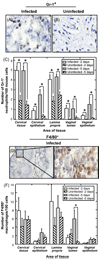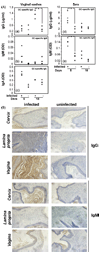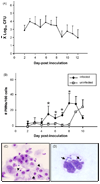Local and humoral immune responses against primary and repeat Neisseria gonorrhoeae genital tract infections of 17beta-estradiol-treated mice
- PMID: 18762223
- PMCID: PMC2855896
- DOI: 10.1016/j.vaccine.2008.08.020
Local and humoral immune responses against primary and repeat Neisseria gonorrhoeae genital tract infections of 17beta-estradiol-treated mice
Abstract
The 17beta-estradiol-treated mouse model is the only small animal model of gonococcal genital tract infection. Here we show gonococci localized within vaginal and cervical tissue, including the lamina propria, and high numbers of neutrophils and macrophages in genital tissue from infected mice. Infection did not induce a substantial or sustained increase in total or gonococcal-specific antibodies. Mice could be reinfected with the same strain and repeat infection did not boost the antibody response. However, intravaginal immunization of estradiol-treated mice induced gonococcal-specific primary and secondary serum antibody responses. We conclude that similar to human infection, experimental murine infection induces local inflammation but not an acquired immune response or immunological memory.
Figures







References
-
- Gerbase AC, Rowley JT, Heymann DH, Berkley SF, Piot P. Global prevalence and incidence estimates of selected curable STDs. Sex Transm Infect. 1998;74 June (Suppl. 1):S12–S16. - PubMed
-
- McNabb SJ, Jajosky RA, Hall-Baker PA, Adams DA, Sharp P, Worshams C, et al. Summary of notifiable diseases—United States, 2006. MMWR Morb Mortal Wkly Rep. 2008;55(March (53)):1–92. - PubMed
-
- Hook EW, Handsfield HH. Gonococcal Infections in the adult. In: Holmes KKMP, Sparling PF, Lemon SM, Stamm WE, Piot P, Wasserheit JN, editors. Sexually transmitted diseases. New York: McGraw-Hill; 1999. pp. 451–466.
-
- Tapsall JW. Antibiotic resistance in Neisseria gonorrhoeae. Clin Infect Dis. 2005;41 August (Suppl. 4):S263–S268. - PubMed
-
- Cohen MS, Hoffman IF, Royce RA, Kazembe P, Dyer JR, Daly CC, et al. Reduction of concentration of HIV-1 in semen after treatment of urethritis: implications for prevention of sexual transmission of HIV-1. AIDSCAP Malawi Research Group. Lancet. 1997;349(June (9069)):1868–1873. - PubMed
Publication types
MeSH terms
Substances
Grants and funding
LinkOut - more resources
Full Text Sources
Medical

